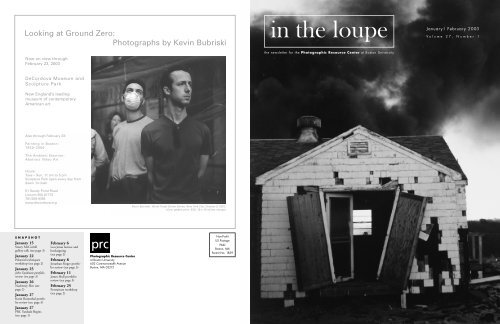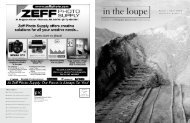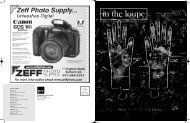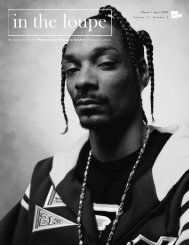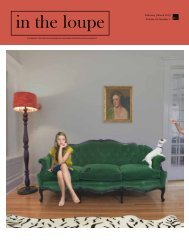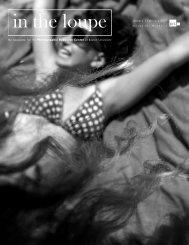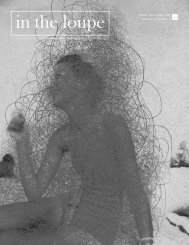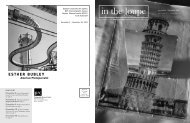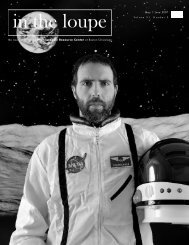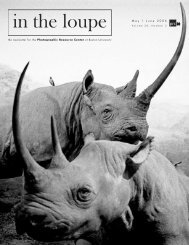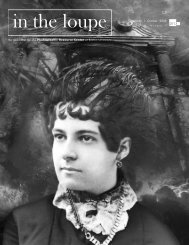January| February 2003 - Boston Photography Focus
January| February 2003 - Boston Photography Focus
January| February 2003 - Boston Photography Focus
- No tags were found...
You also want an ePaper? Increase the reach of your titles
YUMPU automatically turns print PDFs into web optimized ePapers that Google loves.
education programs at the prcWORKSHOPThe Unconventional Portrait:A Workshop withWild Bill MeltonThis program will be a two-part workshop. Theparticipants will meet Tuesday evening at the PRCfor a slide presentation/discussion about portraiture.Melton will present some of his own work,as well as that of other interesting photographers.Participants are encouraged to bring samples oftheir own work to discuss.The second part of the workshop will take placeat Melton’s studio in New Hampshire (45 minfrom <strong>Boston</strong>). This will be a full day of hands-onparticipation with live situations and models. Inaddition to touching upon the technical aspectsof portraiture, Melton will discuss the psychologyof dealing with people. Melton will also talkabout environmental/landscape portraits andstreet shooting, since some of the best portraitsare completely spontaneous.Melton was born and raised in Lake Charles,Louisiana and has been shooting pictures professionallyfor 20 years. He lives in <strong>Boston</strong>, but his business,Wild Bill Studios is based in New Hampshire andNew York City. He shoots advertising campaigns,fashion, and annual reports for clientele worldwide.Some of his most notable clients are Lapham Miller,Cambridge University, Young and Rubicam, TheMetropolitan Museum of Art, Agilent Technologies,Coca-Cola, Hewlett Packard, and Continental© Wild Bill Melton.Airlines. Most recently he shot the worldwide printcampaign for Schweppes starring Clive the spottedLeopard. Over the years he has become one of theworld’s premier exotic animal photographers bringingthe animals into “human like” situations. Pleasevisit www.wildbillstudios.com for more information.Lucas Samaras, Untitled, 1974, Manipulated Time ZeroSupercolor photograph. © Lucas Samaras. Courtesy of thePolaroid Collections.Creative Polaroid Techniques:A Seminar withDick LombardiWednesday, January 22, 2002, 6-9pmPhotographic Resource Center$55 Members/$75 Non-MembersReservations required.Please call 617-353-0700The most common creative uses of Polaroid filmsand imaging solutions are Image Transfer, whichis a dye transfer process that involves peelingapart the negative prematurely; Emulsion Lift,which involves soaking the Polaroid print andlifting the emulsion off the paper; and SX-70Manipulation, which involves the manipulationof the image-bearing gel within SX-70 film. Thisthree-hour seminar will cover these three techniquesstep-by-step, and will introduce you toendless variations of these basic processes. Thisseminar will inspire you to add an individual creativetouch to your Polaroid images. All participantsare encouraged to bring a 35mm slide.James Nachtwey.FILMWar PhotographerA Documentary Film on James Nachtwey,presented as part of the Human Rights WatchInternational Film Festival. Directed andproduced by Christian Frei-Switzerland-2001.Co-presented by the Human Rights Watchand the Northeastern University School ofJournalism.Sunday, January 26 <strong>2003</strong>, 1pm.Coolidge Corner Movie Theatre. All tickets $9.Tickets go on sale December 15, 2002 at theCoolidge Corner Movie Theatre.In one of the world's countless crisis areas, surroundedby suffering, death, and chaos, awardwinningphotographer James Nachtwey searchesfor a picture that will convey what he sees to therest of the world. He’s a shy man who is consideredone of the bravest and most important warphotographers of our time, but he hardly fits thecliché of the hard-boiled war veteran. If webelieve Hollywood pictures, war photographersare all macho men and cynical old troupers. Howcan they think about "exposure time" in the verymoment of dread? Nachtwey is no rumblingswaggerer, but an unobtrusive man with gray hairand the deliberation of a lecturer in philosophy.(2002 Academy Award nominee, documentaryfilm)Director and producer Christian Frei followedJames Nachtwey for two years into the wars ofIndonesia, Kosovo, Palestine…He used specialmicro-cameras attached to Nachtwey’s own camera.The audience sees Nachtwey looking for thedecisive moment. They see what the photographeris seeing and hear every breath he takes. Forthe first time in the history of movies, this techniqueallowed for an authentic insight into thework of a concerned photo-journalist.Fifteen years ago, Human Rights Watch createdthe Human Rights Watch International Film Festivalin recognition of the power of film to educateand galvanize a broad cross-section of concernedsupporters. Human Rights Watch’s InternationalFilm Festival has become a leading venuefor distinguished fiction, documentary and animatedfilms and videos with a distinctive humanrights theme. The Human Rights Watch InternationalFilm Festival brings its program of challengingand provocative films back to <strong>Boston</strong> fora third season with a four-day festival runningJanuary 23-26, <strong>2003</strong>.LECTURESFinal Exposure: Portraitsfrom Death Row –Newly Republished by AFSCA Lecture and Book Signing by Lou JonesThursday, <strong>February</strong> 6, <strong>2003</strong>, 6pmPhotographic Resource CenterFree to the public.Reservations recommended.Please Call 617-353-0700In 1990, Jones began a six-year odyssey of documentingmen and women on death row. Theresulting photo project and book, Final Exposure,published in 1996 by Northeastern UniversityPress, was soon sold out. <strong>2003</strong> brings therepublication of the book by the AmericanFriends Service Committee. Newly rewrittenand redesigned, it offers additional photographswhile maintaining the sense of stark reality thatdefines its immense impact. Books are availableonline at www.afsc.org/resource/newlist.htm, orby calling 888-988-2372.Jones is one of <strong>Boston</strong>’s most diverse fine art andcommercial photographers. This award-winningphotographer specializes in advertising,corporate and editorial projects, with a uniqueroster of clients such as National Geographic,Paris Match, the MFA, Major League Baseball,and many more. He graduated from collegewith a degree in Physics, but soon after started acareer that would have him taking pictures ofheadhunters in Borneo and guerrillas in CentralAmerica, flying upside down with aerobaticpilots, skulking around opium dens in Singapore,sailing on tall ships and aircraft carriers,and being incarcerated in more foreign jails thancan be counted. In addition to all of this, he hasphotographed ten successive Olympics Games.His work has been exhibited throughout theworld including the Smithsonian and CorcoranGalleries in Washington DC, the San FranciscoMuseum of Modern Art, and the Feuerwagnerin Austria. In May 2000, the International PhotographicCouncil of the United Nations presentedhim with their highest award.PRC CURATORPORTFOLIO REVIEWSBelow you will find dates for our monthly portfolioreviews (and corresponding call-in reservationinformation) with the PRC’s Curator, LeslieBrown. As before, the reviews are 45 minuteslong and scheduled on the hour beginning at9:00 am with the last one at 3:00 pm. Reservationswill be accepted on a first-call, first-servedbasis. It is highly recommended that you bringsupporting materials (resume, images, and statement).Review Date: Monday, <strong>February</strong> 24, 2002(call in for reservations at 10 am, Friday, January17th)Review Date: Monday, March 10, <strong>2003</strong>(call in for reservations at 10 am, Friday,<strong>February</strong>)GUEST PORTFOLIOREVIEWSIn addition to the monthly critiques given bythe PRC curator, the PRC offers regular portfolioreviews with invited experts. This opportunityallows photographers to have their workseen by nationally-known museum professionals,gallery owners, critics, and artists. The January/<strong>February</strong>portfolio reviews are:John GoodmanPhotographerReview Date: Saturday, January 25, <strong>2003</strong>Call-in date: 10 am, Friday, January 10,<strong>2003</strong>Goodman’s work is in many of the country’smost important collections, including those ofThe Art Institute of Chicago, the Museum ofFine Arts, <strong>Boston</strong>, the Museum of Fine Arts,Houston, and San Francisco Museum of ModernArt. He has published and exhibited extensivelyand has gained acclaim for his commercialwork. For more information, visit www.goodmanphoto.com.Karin RosenthalPhotographerReview Date: Monday, January 27Call-in Date: 10 am, Friday, January 17,<strong>2003</strong>Karin Rosenthal’s signature nudes are publishedinternationally and are included in the collectionsof the Museum of Fine Arts, <strong>Boston</strong>, theBrooklyn Museum of Art, Fogg Art Museum,and Polaroid, among others. Her work wasrecently published in Karin Rosenthal: TwentyYears of Photographs.Lou Jones, Terry Johnson, Connecticut, 7/94.Jonathan SingerPhotographerReview Date: Saturday, <strong>February</strong> 8, <strong>2003</strong>Call-in date: 10 am, Friday, January 31,<strong>2003</strong>(Call for reservations)Singer is the founder and owner of Singer Editions.Located in <strong>Boston</strong>, Singer Editions is afine art digital printmaking studio specializingin the production of limited edition color andblack and white Iris prints. Affiliated with NashEditions in California, Singer Editions is and hasbeen one of the leading presses in the developmentand proliferation of fine art digital printing.Singer is on the Board of Directors of thePRC and is a diehard fan of the <strong>Boston</strong> Red Sox.James HullArtist and Director of the Gallery at Green StreetReview Date: Tuesday, <strong>February</strong> 11, <strong>2003</strong>Call-in date: 10 am, Friday, <strong>February</strong> 7,<strong>2003</strong>The Gallery @ Green Street is an alternativeexhibition space located in a subway station in<strong>Boston</strong>. The space is non-profit, artist-funded,and artist-run and was made possible by theMassachusetts Bay Transportation Authority(MBTA). Its mission puts contemporary artworkinto contact with a wider audience byusing non-traditional exhibition venues in existingpedestrian traffic patterns. Hull has beenorganizing exhibitions and acting as an art handlerand installation expert since 1990. Hull alsoruns the <strong>Boston</strong> Drawing Project housed at theBernard Toale Gallery. For more informationvisit www.jameshull.com.Lou JonesPhotographerReview Date: tba(Call for reservations)See lecture listing for biography.23
Rest assured.®PETER MALY BED. Design: Peter Maly. Distinctive, understated furniture beautifully crafted in France.Selected designs available for immediate delivery. Visit us and experience the innovation and subtle luxury of Ligne Roset.ADESSONEW EUROPEAN FURNITURE, LIGHTING AND ACCESSORIES200 Boylston Street, <strong>Boston</strong> (adjoining the Four Seasons Hotel)tel 617-451-2212 - www.adesso-boston.comOpen 10-6 Monday–Saturday, 12-5 Sunday4 5
insightChris EnosAn Interview withThe founder of the Photographic Resource Center, Chris Enos is an artist and educator whohas been making and exhibiting work for over 30 years. Californian by birth, Enos holds aMaster of Fine Arts in <strong>Photography</strong> from the San Francisco Art Institute and has taught atHarvard University, the Rhode Island School of Design, Smith College, and <strong>Boston</strong> University.Since 1986, Enos has been on the faculty of the University of New Hampshire in Durham.Her work has garnered numerous awards, and is found in such collections as those of theGeorge Eastman House, the J. Paul Getty Museum, The Fogg Museum, the Museum of FineArts <strong>Boston</strong>, and the San Francisco Museum of Modern Art. Her current work is in mixedmedia utilizing painting, sculpture, and collage. She currently lives on Plum Island in northeasternMassachusetts.Tell me about the beginning of the PRC?When I moved to <strong>Boston</strong>, there was lots of stuffgoing on in different places that nobody knewabout. Harvard had a lecture series and movies.The Museum School was doing things. Mass Artwas doing things. One school didn’t know aboutthe other and nobody would share any information.The schools would bring people in fromthe outside, at a pretty big expense, but only afew people would benefit from it. It seemed likewhat they needed was an information clearinghouse.I just happened to have time on my handsbecause I didn’t have a job. That’s why thenewsletter started.The PRC originally started as a newsletter?Yes, that was the basis of it.How were Jeff Weiss and A.D. Colemaninvolved in the founding?The reality was that Jeff, Alan, and I wouldbrainstorm. Then Alan would go back to NewYork and Jeff would go back to Vermont and Iwould do all the work. [laughter] Then Alanstarted Views, which he worked quite hard on.Mostly, it was the three of us sitting around, gettingstoned, and coming up with ideas. We reallyliked each other and had a really good time. Itgave us a common cause.How was the newsletter distributed?I took it to stores and photo labs. I just walkedthe town. That was another reason why I kneweverything that was going on because I would goeverywhere, drop off the newsletters, and talk topeople. Kelly Wise was great. I told him aboutthe idea of the PRC and he said, “Yeah, it wouldbe a great idea if it had the right Director.” I said,“Thanks a lot Kelly!” [laughter]It wasn’t all pleasant, but I just did it. When Idecide to do something, I do it. Originally wewere under the Artists Foundation. They werethe umbrella so we could do a nonprofit mailingbecause I had no money. None. I was tryingto work three different teaching jobs just so Icould piece enough together to pay my. It was alabor of love.How did the affiliation with the ArtistsFoundation start?I told the Director, Richard Linzer at thatpoint, what I wanted to do and he told my howto do it. Basically, everybody told me I wascrazy because there had been a bunch of organizationsthat had come and gone and nobodyever thought that any of them could last. Myidea was to keep it broad. The problem withartist organizations is that they are too small.They can’t get enough backing. It seemed to methat in photography we needed to service andinvolve people from all walks of photography.So, when we had a lecture series, we’d haveHiro and Pete Turner…people whose work Iam not really interested in but they would be abig draw to the organization. Then, we wouldbalance that off with journalists and art photographers.We’d just try to keep anybody who wasinterested in photography in any way to stayinterested in the organization. I still think that’swhy it worked.Where did you do the lecture series?I think we had most of them at <strong>Boston</strong> Universitybecause Carl Chiarenza was very involved.He was on the Board and really believed in thePRC. He was responsible for getting us to BU.He was the one who could find us a space largeenough for us to have lectures.How did the PRC get out of your apartment?I went to various places to see if we could eventuallyget the organization out of my loft. It wasonly one room. I couldn’t get away! It was on thecorner of Beech and Atlantic across from SouthChris Enos. Photograph by Terrence Morash.Station. Once we moved out of my loft, it wentto <strong>Boston</strong> University. It went to Buick Street,then Commonwealth Avenue, and then to whereit is now.When did it become an exhibition space?When it moved to where it is now. I never reallyenvisioned it as a gallery because I think that isso expensive. I always thought that it would bebetter to work with other institutions. Take theexpertise of the Resource Center and get exhibitionsout into the community. I was not thrilledby it becoming a gallery.Were you still part of the PRC at that point?Not really. I had moved to New York and wasteaching at ICP. Then I went out to UCLA andtaught out there for a year. I needed to make aliving after a while. I had to get a job.I really got pretty disgusted with what was goingon [at the PRC] for a while. It got so much aboutart and so elitist. I remember they had a showabout paper cups. I can’t remember the artist’sname, but the cups had names attached tothem…something to do with either the Congressor Senate. It was a political statement. Itwas conceptual for maybe a couple of days, butto take up the gallery space and that muchmoney to have a show that was so removed fromeverybody’s experience was ridiculous. I believein having some of that, but it got to the pointthat it was too far. I remember there were thesethree shows that they wanted to do—one on lesbianphotography, one on the holocaust, and oneon something else. I couldn’t understand whythey couldn’t have one of those a year and balanceit off with other things. I think you reallyhave to appeal to a broad audience if you aregoing to survive. I think they got way too far offinto the artsy world. It became art about art.They forgot about all of the rest of it. I thoughtthat was unfortunate and that it alienated a lotof people.Looking back, how do you feel about yourrole as the founder of the PRC?I am amazed it’s still there. It is very difficult tokeep something like that going year after yearafter year. At one point, I really thought that itwas going to die. There was no money, andnobody knew how much of the money was therebecause nobody kept track of it. Fortunately,there was enough goodwill from people to pickup and go again.Where would you like to see the PRC go fromhere?To me, education is the most important part. Ithink you’re doing the right things as far asexpanding the newsletter, but it could have morein it. I would like to see some reviews of other[institution’s] things and not as much aboutwhat the PRC is doing—sharing informationabout who is around and what they are doing.Why photography?I have a degree in sculpture. At the end of mycollege years, I got into photography and wasfascinated with how little had been done in themedium at that point. It was the mid-1960s.Also, I could do it all myself. In sculpture, I wasalways stuck needing help. I felt very independentas a photographer. I then went to the SanFrancisco Art Institute and got a Masters in photography.What led to your shift to documentary photographywhen you moved to the East Coast?I photographed nudes when I was in California.We were hippies. I lived in Haight Ashbury. Wewere going to nude beaches a lot and it seemedto me that if you were going to have anything tosay in your work, it had to do with your observationsand your lifestyle. I photographed nudesfor eight years. When I got to the East Coast, itjust didn’t make that much sense. You would goout and there were bugs and it was too cold.[laughter] I started photographing the landscape.That evolved into the relationshipbetween people and nature and the struggle fornature to survive. I worked on that for about tenyears. Then it evolved into garbage and I madethe little book of SX-70s of garbage at the Haymarket.Your work seems to be constantly changing.I have always just kept moving. I have so manyideas right now that I could never do them all.I know what I will be doing as soon as I canretire from making a living. It has to do withother dimensions—metaphysics. Lookingthrough where we are right now to otherspaces. It’s something that I think about all ofthe time. When my work starts to get boring, Imove, or I change. I always tell my students,“If your work is boring, take a look at yourlives.” I really believe that. You have to stayalive to be an artist. I develop ideas for years ata time, but when it starts getting repetitive, Imove on to something else.(Clockwise from top left) Untitled; Gaia, 1999;Untitled, mixed media.How do you balance “making a living” anddoing your own work?That struggle is never-ending—even when I wasrunning the PRC. That was when it was such agreat time to use that Polaroid studio. I coulduse it in a very concentrated period of time andthen go back and do what I had to do. It was afabulous opportunity at that particular time inmy life. Now you can have that instant experiencewith the computer. You can go out andshoot and come back and print and have it alldone in a day. That’s really fabulous. In fact, thatmade me a little nervous because it doesn’t takevery long and I am used to spending a lot oftime on things. That’s why I started painting. Iwanted to expand it longer. I wanted to be moreinvolved with it physically. I think that I willcontinue to work with the photograph, butmanipulate it into other dimensions. That’s avery interesting basis for that because youassume that the photograph took place in theworld that we’re in and what I am interested inis different space and different time.You mentioned that you will be moving toTaos in a few years. It will be interesting tosee how your work changes.The whole spiritual quality of the mountains inthe Southwest and where I am mentally in thejourney between birth and death is a very interestingplace right now. It takes a long time to gethere! [laughter] It’s very spiritual, but not religious.Joseph Beuys is my favorite artist at thispoint. He’s really dealing with that otherworld—other dimensions and metaphysics. I amvery fascinated with that exploration.Thank you Chris.Thank you.67
ook reviewsThis issue, the PRC is pleased to present tworeviews written by BU Art History graduate students.Due in part to the scholarship and commitmentof Dr. Kim Sichel, BU has forged aname for itself in the field of photohistory. Inwhat hopes to be an ongoing partnership, we willbe spotlighting the tremendous talent of the BUart history department.My GhostAdam Fuss and Jerry KellySanta Fe: Twin Palms Publishers, 48 pages, $853000 copies in the first edition, 2002.As if asked to represent the intangible, Adam Fusscreates in My Ghost a visual record of memory,movement, loss, love, and the passage of time.While only 48 pages long, the volume’s substantialsize at nearly 15 by 12 inches absorbs theviewer. The majority of the photographs explorethree subjects – birds in flight, curling smoke, andold-fashioned children’s dresses and christeninggowns.The subject matter of Fuss’s photographs revealshis interest in abstract concepts, but it is his techniquethat heightens a viewer’s perception of theseconcerns. Much of My Ghost relies on inherentlyphotographic qualities.To create his dialogue with the past, Fuss resurrectstwo photographic methods from the 1830s:daguerreotypes and photograms. Daguerreotypes,once popular for studio portraits, feature a thinwhite photographic positive image on a silvercoatedsheet of copper. When overexposed, whiteareas of the daguerreotype can become blue; inthe 19th century this was considered an error, butFuss exploits this unique quality to provide bluewithin some images, as well as the light bluepalette used for the books’ endpapers and text.Photograms are made by exposing objects placeddirectly on or in front of photographically sensitivepaper, capturing the object’s form. Whilesmoke is ephemeral, Fuss’s photograms stop itsmotion, so it appears physical and solid. The photogramsof dresses, remarkably, function in theopposite way. The dresses, with their lace,embroidery, and tulle, placed upon the photographicpaper, lose definition as light wrapsaround their threads. The images simultaneouslyshow the front and back of the dress, and yet stillseem impermanent. Fuss stops motion withsmoke, but emphasizes movement when photographingbirds. Bird bodies appear clearly whilefuriously flapping wings fade into blurry indicationsof activity. Fuss suggests the fleeting througheach of these themes. You fear your eyes deceiveyou – you perceive smoke, the flight of birds, adress, once preserved in tissue paper, nowunwrapped and presented before you. But if youblink it may all be gone.The interspersed text builds on the sense of thetransitory. Poetry and prose printed in a faint lightblue on the heavy cream paper seem to materializeand dematerialize as you look, appearing tochange. Poetry by Russian writer ArsenyTarkovsky hints at new love, age, and sadness.Prose by Neville Wakefield tackles loss and deathmore concretely, such as, “A boy is born and diesin a hospital. He never knows his parents. Theybecome orphans of their own child.” With thatliterary image Fuss’s photographs of children’s garments,already looking fragile and old, appearempty and cool as well.The title My Ghost suggests that the imagesshould be haunting. Instead they promote contemplationof the range of human emotions thatlife requires of us. Throughout the book, the principleof ascension dominates – the smoke rises,birds head skyward, even the dresses, in their generalshapes, seem to create arrows pointingtowards the top of each page. With this sense oflifting, optimism infuses the whole, and encouragesus to stay longer, to enjoy visiting not justwith Fuss’s ghost, but with our own.– Becky Benf, Ph.D. Candidate, Art HistoryDepartment, <strong>Boston</strong> UniversityPrint the Legend: <strong>Photography</strong>and the American West,Martha A. Sandweiss416 pagesNew Haven: Yale University Press, 2002.Martha A. Sandweiss derives the title of her newbook from the classic line in John Ford’s 1962western, The Man Who Shot Liberty Valance, inwhich the newspaper editor states: “This is thewest, sir. When the legend becomes a fact, printthe legend.” Lucidly written and extremely readable,Sandweiss chronicles numerous images ofthe American West produced in the 19th century,from early daguerreotype portraits and landscapes,photographs taken during the MexicanAmerican War, civilian and army survey photographsof American Indians, and Gold Rush photographs,to the photographic albums of the FourGreat Surveys of the American West of the 1860’sand 70’s. Sandweiss explores the complex relationshipof the West to photography in the contextof American history, culture and literature ofthe period, carefully examining how photographyshaped Americans’ perceptions of the West andalso how the West influenced the photographerswho sought to capture it on film. Closely readingand often comparing the different forms of visualrepresentations of the West – including painting,photography, lithography and woodcuts (whichare beautifully reproduced in the many illustrativeplates), Sandweiss concludes that often, what wascaptured on film or daguerreotype plate, did notfit 19th century America’s preconceived notion ofthe American West. Rather, the public desired aconstructed view of the West that fit the legend,not the fact.This invaluable book for both students of photographyand American History tackles the relativelynew field of photographically illustratedbooks by looking at historical photographs andtheir relationship to other forms of visual representationin the 19th century. Exploring not onlythe complicated issues surrounding photographyas a documentary form as well as a new artisticmedium, Sandweiss beautifully explicates the tensionbetween the 19th century predilection forconstructed views of the West and the often differentreality captured by photographers in thefield. Sandweiss astutely notes the resistance ofthe 19th century public to photographic images,and their “lingering preference” for more dramaticnarrative and decorative forms of illustration.Here one cannot help but draw an analogyto our own 21st century wariness of all things digital.Just as the 19th century public was still learninghow to read a photograph, so we also strugglewith how to read a digital image, an email, perhapseven a book on-line. Sandweiss’s engagingbook introduces the subject of photography andthe American West and ends in a reflection onhow Americans understand and picture themselves.By presenting, but not definitively answeringquestions as to how the 19th century publicunderstood, read, and ultimately did or did notappreciate this new visual medium, Sandweiss’sbook is hopefully not the end of the discussion,but rather an invitation for more investigationinto the fields of photography, photographicbooks, and correlating images of the AmericanWest.– Melissa Renn, MA student, Art History Department,<strong>Boston</strong> UniversityBooks reviewed for in the loupe can be found in thePRC Library.Mead ad (technical difficulties)89
photography events in new england and beyondEXHIBITIONSMASSACHUSETTSArt Complex Museum at DuxburyThe Inner Eye: Pinhole Photographs by Jesseca Ferguson(thru Jan 12). Wed-Sun, 1-4. 189 Alden St., Duxbury,MA 02331. 781-934-6634.www.artcomplex.orgArt InteractiveTime Share (includes work by Jane Marsching, MichaelMittelma, Andrew Neumann, Scott Snibbe, Jeff Talman,and Camille Utterback) (thru Jan 5). Sat & Sun,10-5. 130 Bishop Allen Dr., Cambridge, MA 02139.www.artinteractive.org<strong>Boston</strong> University Art GallerySelections from American Perspectives: Photographs fromthe Polaroid Collection (exhibition in conjunction withthe PRC) (thru Jan 26). Tue-Fri, 10-5; Sat-Sun, 1-5.855 Commonwealth Ave., <strong>Boston</strong>, MA 02215.617-353-3329. www.bu.edu/artBromfield Art Gallery<strong>Photography</strong> by Jessica Jacobs (Jan 8-Feb 1).Wed-Sat, 12-5. 11 Thayer St., <strong>Boston</strong>, MA 02118.617-451-3605. www.bromfieldartgallery.comDanforth Museum of ArtNew England Currents: Eric Lewandowski (thru Jan18). Wed-Sun, 12-5. 123 Union Ave., Framingham,MA. 508-620-0050. www.danforthmuseum.orgDeCordova Museum and Sculpture ParkLooking at Ground Zero: Photographs by Kevin Bubriski(thru Feb 23). Tue-Sun, 11-5. 51 Sandy Pond Rd.,Lincoln, MA 01773. 781-259-8355.www.decordova.orgEssex Art CenterKyogen (Jan 17-Feb 28). Tue-Thu, 10-7; Fri, 10-3.56 Island St., Lawrence, MA 01840. 978-685-2343.www.essexartcenter.comFitchburg Art MuseumAdams and O’Keefe on the Road and Eliot Porter: LandscapesEast and West (thru Jan 12). Tue-Sun, 12-4.185 Elm St., Fitchburg, MA 01420. 978-345-4207.www.fitchburgartmuseum.orgFort Point Arts Community GalleryDouble Vision: One Landscape, Two Photographers(thru Jan 24). Mon-Fri, 10-3; Sat, 12-5.300 Summer St., <strong>Boston</strong>, MA 02110. 617-423-4299.www.fortpointarts.orgGallery NAGAJaclyn Salvaggio: Photographs (Feb 7- March 1).Tue-Sat, 10-5:30. 67 Newbury St., <strong>Boston</strong>, MA02116. 617-267-9060. www.gallerynaga.comGallery ISOSurface and Place: Photographs by Jennifer Uhrhane(thru Jan 30). Open by appt. only; special hours onJan 11, 11-4pm. 140 Kemble Street, <strong>Boston</strong>.617-427-4144.Harvard University Art MuseumsBusch-Reisinger MuseumWolfgang Tillmans: Still Life (thru Feb 23). Mon-Sat,10-5; Sun, 1-5. 32 Quincy St., Cambridge, MA02138. 617-495-9400. www.artmuseums.harvard.eduHoward Yezerski GalleryGlow: Polaroids by Amanda Means (Jan 4-Feb 11).Tue-Sat, 10-5:30. 14 Newbury St., <strong>Boston</strong>, MA02116. 617-262-0550.www.howardyezerskigallery.comLawrence Library Art MuseumLandscape <strong>Photography</strong> by Janet Koenig Picinich (Jan11-Feb7). Tue, 1-8; Wed-Thur, 9-8; Fri-Sat, 9-5.Lawrence Library, 4 Brick Pond Way, Pepperell, MA.978-433-0331.Mead College Museum of ArtCritical Mass: Happening, Fluxus, Performance, andIntermedia at Rutgers University 1958-1971 (Feb 1-June 1) and American Edge: Photographs by SteveSchapiro ( Jan 24-Mar 23). Tue-Sun, 10-4:30; Thur,10-9. Intersection of Rte. 9 and South Pleasant St.,Amherst, MA. 413-542-2335. www.amherst.edu/meadMuseum of Fine Arts, <strong>Boston</strong>Lens Landscape (thru Feb 23), Adam Fuss (thru Jan12), and The <strong>Photography</strong> of Charles Sheeler: AmericanModernist (thru Feb 2). Mon-Tue, 10-4:45; Wed–Fri,10-9:45; Sat-Sun, 10-5:45. 465 Huntington Ave.,<strong>Boston</strong>, MA 02115. 617-267-9300. www.mfa.orgNew England School of <strong>Photography</strong>Gallery OneWorkshop Show (thru Jan 30) and Keith JohnsonPhotographs (Feb 10-March 14). Mon-Fri, 9-5.537 Commonwealth Ave., <strong>Boston</strong>, MA 02215.617-437-1868. www.nesop.comPanopticon GalleryPhotographs by Nubar Alexanian: A Retrospective(Dec 12-Feb 15) and Photographs by Charles Gauthier(Feb 19-March 29). Mon-Fri, 10-6; Sat, by appt.435 Moody St., Waltham, MA 02453. 781-647-0100.www.panopt.comPeabody Essex MuseumBohnchang Koo: Masterworks of Korean <strong>Photography</strong>(thru Feb 18). Tue-Sat, 10-5; Sun, 12-5. East IndiaSquare, Salem, MA 01970. 978-745-9500.www.pem.orgPeabody Museum of Archeology and EthnologyCharles Fletcher Lummis: Southwestern Portraits 1888-1896 (thru March). Mon-Sun, 9-5. 11 Divinity Ave.,Cambridge, MA 02138. 617-496-0099.www.peabody.harvard.eduPepper GalleryThe Winter Salon Show (featuring mixed media andphotographs by Pamela Ellis Hawkes, Kahn Selesnickand Lance Keimig) (thru Jan 11). Tue-Sat, 10-5:30,and by appt. 38 Newbury St., 4th floor, <strong>Boston</strong>, MA02116. 617-236-4497. www.peppergalleryboston.comRobert Klein GalleryMichal Ronnen Safdie (thru Jan 31). Tue- Fri, 10-5:30;Sat, 11-5. 38 Newbury St., <strong>Boston</strong>, MA 02116. 617-267-7997. www.robertkleingallery.comSouth Shore Arts CenterWho’s Who?: Faculty Photographs by Lance Keimig andTom Hammend (Jan 10-Feb 23). 119 Ripley Rd.,Cohasset, MA 02025. 413-597-2429. www.ssac.orgThe Valley Portfolio Photographic CenterPixels (thru Jan 31). Tue-Sat, 11-2; Thur, 6-9. 1500Main St., Springfield, MA 01115. 413-781-1553.www.portfolio.comWilliams College Museum of ArtFrom the New York Collection (thru March 23).Tue- Sat, 10-5, Sun, 1-5. 15 Lawrence Hall Dr., Ste. 2,Williamstown, MA 02116. 413-597-2429.www.williams.edu/wmca.Worcester Art MuseumMask or Mirror?: A Play of Portraits (various mediums)(thru Jan 26). Wed-Fri, 11-5; Sat, 10-5; Sun, 11-5.55 Salisbury St., Worcester, MA 01609. 508-799-4406. www.worcesterart.orgZonaGary Barsomian (Jan) and Sudbury Valley <strong>Photography</strong>Club (Feb). Mon-Fri, 8-8; Sat, 10-4. 561 Windsor St.,Somerville, MA 02143. 617-628-2545.The Art Institute of <strong>Boston</strong> at Lesley University,through the Office of Continuing and ProfessionalEducation is offering Winter/Spring <strong>2003</strong> workshopsin Digital Media, <strong>Photography</strong>, Marketing, and Framing/Matting.Upcoming courses are Introduction toBlack & White <strong>Photography</strong>, with Ruth MolinaWalker, Writing for Photojournalists: The WritingPhotographer, with John Suiter, and Marketing forPhotographers, with Jeffrey Brown, among many others.Inquiries may be directed to Diana Arcadipone,617-585-6729. www.aiboston.edu/EXTRAThe Art Institute of <strong>Boston</strong> and The French-AmericanCollaborative in Language and Art will host its7tth and 8th workshops "<strong>Photography</strong> as an Art" inthe early spring in the Caribbean, and in Paris in thesummer of <strong>2003</strong>. These unique week-long intensiveworkshops will cover the technology of film and caminthe loupe listings deadlinesMarch/April issue:January 15, <strong>2003</strong>May/June issue:March 15, <strong>2003</strong>ELSEWHERE IN NEW ENGLANDFarnsworth Art MuseumAll of Pierce: From <strong>Boston</strong> to Baghdad (thru Mar 16).Tue-Sat, 10-5; Sun, 1-5. 365 Main St., Rockland, ME04843. 207-596-6457. www.farnsworthmuseum.orgHartford Center for Contemporary CultureThis is Then, (thru Feb 15) Main Gallery.Call for hours. 56 Arbor St., Hartford, CT 06106.860-232-1006. www.realartways.orgHood Museum of Art at Dartmouth CollegeAmbassadors of Progress, American Women Photographersin Paris 1900-1901 (Jan 4-Mar 9) and Carrie MaeWeems “The Hampton Project” (Jan 18-Mar 9).Tue–Sat, 10-5; Wed, 10-9; Sun, 12-5. DartmouthCollege, Wheelock St., Hanover, NH 03755.603-646-1400. www.dartmouth.edu/~hoodPortland Museum of ArtMigrations: Humanity in Transition, photographs bySebastião Salgado (Jan 23-Mar 23). Tue, Wed, Sat, andSun, 10-5; Thur and Fri, 10-9. Congress Square,Portland, ME 04101. 207-775-6148.www.portlandmuseum.orgSaco MuseumThe Friends of Al Carbee: <strong>Photography</strong> and Collage byAl Carbee (thru Feb 27). Sun, Tues, Wed, 12-4;Thurs, 12-8 and Fri, 12-4. 371 Main St., Saco, ME04072. 207-283-3861.Salt Institute for Documentary StudiesStudent Show (Dec 20-Feb). Mon-Fri, 11:30-4:30;First Fri, 5-8pm. 110 Exchange St., Portland, ME04112. 207-761-0660. www.salt.eduUniversity of Maine Museum of ArtCollete Urbajtel and Manuel Alvarez Bravo: Photographs1930-1996 (Dec 6-Jan 18).American Ground: Unbuilding the World Trade Center.Images by Joel Meyerowitz (Dec 6-Jan 18).Tue-Sat 9-6pm; Sun 11-5. Norumbega Hall,40 Harlow St., Bangor, ME 04401. 207-561-3350.EDUCATIONeras, correlations with the artistry of photographiccomposition, along with readings from the literature ofart and photography. These workshops are designed forbeginner and intermediate students and college creditis available. Costs range from $995-$1295 per personexcluding airfare. Please check out the website atwww.facilart.net for details or call Regis de Silva at 617482 8055.The Cape Cod Photo Workshops offers a wide varietyof courses on photography. For more informationplease contact Cape Cod Photo Workshops at 508-255-6808. P.O. Box 1619, N. Eastham, MA 02651.The Essex Art Center offers classes in all artisticmedia, including photography. The Essex Center forart is located at 56 Island Street, Lawrence, MA01840. For more information go to www.essexartcenter.comor call 978-685-2343.Horizons to Go Travel Programs offers classes in allartistic media, including photography. For more informationand prices please contact Horizons to Go! POBox 2206, Amherst, MA 01004, or go to www.horizons-art.comor call 413- 549-2900.John Sexton Photo Workshops offers a wide varietyof courses on photography. For more informationplease contact us on the web at www.johnsexton.com.John Sexton <strong>Photography</strong> Workshops, 291 LosAgrinemsors, Carmel Valley, CA, 93924.The Lesley Seminars at Lesley University will offerHolly Smith Pedlosky’s class <strong>Photography</strong> and Being aWoman: Identity & Eros, 1839-Present. Jan 23-May 5,<strong>2003</strong>. Mondays 10:30am-1pm. Tuition $830 (noncredit)and $870 (credit). For more information, contactMercedes Barletta at Lesley University: 617-349-8609; email: barletta@mail.lesley.edu.The Maine Photographic Workshops will be offeringa large variety of <strong>Photography</strong> workshops. The MainePhotographic Workshops are located at 2 CentralStreet, PO Box 200, Rockport, ME 04856. For moreinformation go to www.theworkshops.com or call 1-877-577-7700.Santa Fe <strong>Photography</strong> and Digital Workshops arehosting a wide variety of workshops and programs thisWinter. For more information contact Santa Fe Workshops,PO Box 9916, Santa Fe, NM 87504-5916, orgo to www.santafeworkshops.com or call 505-983-1400.Snow Farm, The New England Craft Program offersclasses in all artistic media, including photography. Formore information please contact Snow Farm at 5 ClaryRoad, Williamsburg, MA 01096, go to www.snowfarm-art.org,or call at 413-268-3101.South Shore Art Center offers classes in all artisticmedia, including photography. The South Shore ArtCenter is located at 119 Ripley Rd., Cohasset, MA02025. For more information go to www.ssac.org orcall 781-383-2964.ENTRIES/OPPRTUNITIESAbout the Arts invites artists working in all media tosubmit work for a new television series airing in <strong>2003</strong>.About the Arts was created in 1995 to provide exposureand visibility to the arts and bring local artists to theforefront. It has produced more than 250 visual, performing,literary, and media artists, museums, andgallery events. The series aims to produce 12 half hourdocumentaries on artists who bring awareness to issuessuch as racism, AIDS, poverty, and homelessness. Formore information visit www.aboutthearts.com, emailjamesbrown@aboutthearts.com, or call 617-644-0143.The Cambridge Art Association is placing a call forentries for their National Prize Show, an open exhibitionjuried by Marc Pachter, Director of the National PortraitGallery, Washington D.C. Open to all artists residing inUSA, all media except videos. Work must completedwithin past two years. Entry forms and slides must bepostmarked Jan 17, <strong>2003</strong>. Exhibition runs May 5-June25, <strong>2003</strong> at the Kathryn Schultz Gallery and UniversityPlace Gallery, Cambridge, MA. For more information,go to www.cambridgeart.org.The Camera Club of New York announces its <strong>2003</strong>Small Print <strong>Photography</strong> Competition. Matted printscan be no larger than 154 square inches., equivalent of a11” x 14” matted and framed print. The judges will beDavid Schonauer, Editor in Chief, and Russell Hart,Executive Editor of American Photo Magazine. Deadlinefor submissions: January 15, <strong>2003</strong>. For more informationgo to www.cameraclubofnewyork.org.The Copley Society of <strong>Boston</strong>, in conjunction with the<strong>Boston</strong> Cyberarts Festival, is placing a call for entries forManifest <strong>2003</strong>, and exhibition of visual art in digitalmedia. The jurors will be George Fifield, Curator of NewMedia, De Cordova Museum and Director, <strong>Boston</strong>Cyberarts Festival, Dorothy Simpson Krause, DigitalPrintmaker and founder of Digital Atelier, and MarilynKushner, Curator of Prints and drawings, BrooklynMuseum of Art. Open to all computer related visual artwork,including Digital <strong>Photography</strong>. Submission deadline:January 15, <strong>2003</strong>. The exhibition runs April 10-May 10, <strong>2003</strong>. For more information call 617-536-5049or email karen@copleysociety.org.The Flat Street Center for <strong>Photography</strong> is acceptingportfolios for exhibition dates in <strong>2003</strong>. Send 20 slidesmin. of final prints for exhibition. The gallery will chargea 30 % commission on work that is sold. Details onother artists and gallery responsibilities can be obtainedby writing or calling the gallery located in Brattleboro,VT 05301. www.flatstreetphoto.org1011
phonelines: member news from near and farCongratulations to all for yourrecent successes. Please keep us informedof your news and triumphs.John Kennard recently published a book ofhis photographs Concord, Massachusetts:Photographs by John Kennard, published byCommonwealth Editions.Brick Bottom Open Studios, in Somerville,MA, hosted its 15th Annual ExhibitionShowcase from November 23-24. The exhibitionfeatured works by PRC members, RobertGross, Emily G. Kahn, and RosamondPurcell.Guenter Wehrmann hosted a slide show atthe Newton Free Library, Newton, MA, onWednesday December 11, at 7:30pm. The slideshow featured highlights from his dogsled tripwith Greenland’s Polar Eskimos north of theThule Airbase, and followed the tracks of polarexplorers Robert Peary and Peter Freuchen.Wehrmann is known for his keen interest inthe Arctic and Antarctica and has driven sleddogs in Alaska and has traveled the Alps withhis Siberian Husky.Norman Saracheck will be having a soloexhibit in Gallery 31 at the Visual StudiesWorkshop at 31 Prince Street in Rochester,NY. The show is entitled Marks on Silver:Cameraless Silver Images, and features abstractworks made from manipulated silver gelatinpapers. The show will be open from <strong>February</strong> 7through April 5.The Cambridge Center for Adult Education,Cambridge, MA, hosted a group exhibit, StoriesVisible featuring works by PRC memberKaren Davis, in November. Her works havealso appeared in Variations on the Masters, anexhibit in the Fletcher/Priest Gallery andRestroom, a group exhibit from the MillsGallery, which features works by artists whouse the bathroom as a metaphor for humanexperience and exploration, also in November.Maxine McDonald had a solo show,Ten Light Years- A Photographic Retrospective inthe Hammond Gallery at Fitchburg State College,Fitchburg, MA. The exhibit consisted ofover 60 pieces from various genres including hernew infrared Waterdance Series. The exhibit wason view from October 30 to December 6. Shealso participated in the exhibit, Post Industrial IIat the Brush Gallery in Lowell, MA. Thatexhibit ran from November 3 to January 5.Congratulations to Sid Limitz whose photographwon the grand prize at the <strong>Boston</strong> PublicLibrary’s Night of Stars Benefit on November22. Aproximately 36 other <strong>Boston</strong> based photographersparticipated in the benefit auctionincluding PRC members, Marie Cosindas andRoger Farrington.Last fall, Jaye R. Phillips took part in a photographyexhibit at Concord Academy, Concord,MA, entitled Zero at the bone. Theexhibit was inspired by the poetry of EmilyDickinson.The Julie Saul Gallery in New York, NY,recently hosted John O’Reilly’s exhibit, TheReal Thing. The opening reception and booksigning took place on Friday, October 18 andthe exhibit ran until November 30.The Tufts Street Community Gallery of theArlington Center for the Arts, Arlington, MA,hosted photographs by Margo Cooper fromSeptember 6 through October 16.A Soul in Every Stone, an exhibition of photoillustrations by Michael Berger and SylviaStagg-Giuliano, was on exhibit from October1 through October 31, at the Gallery at NewburyCollege in Brookline, MA.Steve Aishman participated in a dual exhibitentitled Half Asian along with photographerBen Sloat. The exhibit ran from November 9through December 21 at the Safe- T- Gallery inBrooklyn, NY.Andrea Geyer was awarded first prize in theNew England Open <strong>Photography</strong> and SculptureShow, juried by Charles Giuliano.The show appeared at the Kathryn SchulzGallery, Cambridge, MA, from October 10 toNovember 7.The Essex Art Center, Lawrence, MA, displayedThe Midlife Eye, a photo based groupinstallation featuring works by photographersElizabeth Buckley, Karen Davis, AndreaGeyer and Nancy Hart. The installation wasdisplayed in the Elizabeth A. Beland Galleryfrom December 6 to January 3.Water: An Exhibition of <strong>Photography</strong> by ASMPNew England Photographers was held at theMassasoit Community College’s AkillianGallery, Brockton, MA, from October 7through November 1. The exhibit featuredworks by various photographers including;PRC members Steve Dunwell, John Goodman,Paula Lerner, Alex S. Maclean, GregNikas, Marnie Crawford Samuelson, andDavid Wade. Other photographers included;Thomas Ames Jr., John Coletti, Caryn B.Davis, Jim Flynn, John Foraste, Dan Gair,Peter Hvizdak, J. Gregory Raymond, RockyThies, David Wells, D. Jake Wyman and GaleZucker.Raymond St. Arnaud had a solo show at theEnid Mount Joy Gallery in Keizer, OR. Theexhibit was entitled Envisioning Time, Spaceand the Future 5th International Open Competition.It ran for the month of October 2002,and will be featured again at the TarantoGallery in Chelsea, NY, from December 8through January 31.Marjorie Nichol’s photograph, Dog at theWater’s Edge from her Summer ReflectionsSeries was published in the June issue of TheSun, A Magazine of Ideas. The print was thenpurchased by a reader in California.Photographer Susan Wilson presented a slideshow accompanied by music on November 2and 3 of 2002. It documented Mexico’s Day ofthe Dead celebrations. The first show was atthe Pollard Library, Lowell, MA, and the secondshow took place at the Forest Hills Cemetery,Jamaica Plain, MA.Kristen Struebing-Beazley displayed pinholephotographs of New Orleans cemeteries andPolaroid transfer works of cranial imagery in aninstallation at the <strong>Boston</strong> Public Library inNovember, honoring the Day of the Dead2002. She was commissioned by the MexicanConsulate and Urban Arts to produce an altarfor this Mexican holiday. Last July, Struebing-Beazley was given an honorable mention byFellowhip 2002 at the Silver Eye Center for<strong>Photography</strong> in Pittsburg, PA. She exhibitedeleven Polaroid images in the members galleryunder the title Generations: Recycled.WBGH’s Atrium Gallery, <strong>Boston</strong>, MA, hostedHome Portraits of Personal Space, photographsby Lynda Banzi and Stefanie Klavens, fromOctober 7 through November 8.Lance Keimig is in a show at the DolphinGallery in the Hingham public library entitled,Mayo Moments. It consists of 21 black andwhite prints from his last two trips to Ireland.It's on display through January 10.become a member of the prcThe Photographic Resource Center is a membership-supported, privately operated organization. In this period of dwindling government andfoundation support, your membership provides critical income to support our programming and educational mission. Join for theobvious benefits listed below, but also for the more subtle perks. PRC members enter the network of the New England photographiccommunity, which includes commercial and artistic photographers, collectors, scholars, philanthropists, and critics, to name a few. If youlove photography and are interested in supporting our vital mission, join us—your tax-deductible membership does make a difference.PRC MEMBERSHIP CATEGORIES AND BENEFITSIndividual ($45)• Unlimited free admission for one cardholder• Invitation for two to opening receptions, members-onlypreviews and special events• Annual subscription to In the Loupe• Opportunities to present work in the annual MembersExhibition and Members Project Room• Discounts at PRC lectures and workshops• Discounts on portfolio reviews withphotography professionals• 10% discount on PRC exhibition catalogues andother products• Discounts at area darkrooms and retail photographicmerchants• CONNECTIONS (free admission to, or discount at,select photography institutions across the country.Student ($25)• Individual benefits for full-time students only(photocopy of ID required)Family ($60)• Individual benefits for two (two membership cards,one mailing)Supporter ($125)• Family benefits plus• Four guest passes for one-time free admission• Annual PRC exhibition catalogue (when available)• Invitations to special receptions, cocktail parties andgallery talks• Eligibility to rent the Center for private functions(Corporate Member rental rates will apply)Contributor ($300)• Supporter benefits plus• Choice of photographic print from the ContributorMembers Print Program levelBenefactor ($600)• Supporter benefits plus• Choice of a photographic print from the BenefactorMembers Print Program level or two prints from theContributor levelPatron ($1,200)• Supporter benefits plus• Choice of photographic print from the Patron MembersPrint Program level or a combination of prints from theContributor and Benefactor Members Print Program levels(to equal $1,200)Angel ($2,400)• Supporter benefits plus• Choice of photographic print from the Angel MembersPrint Program level or a combination of photographicprints from the Contributor and Benefactor Members PrintProgram levels (to equal $2,400)• Invitation to annual Director’s Dinner• Invitation to private reception with PRC Board of Directors• Additional invitations to all previews and openings uponrequest• Free admission to all PRC lectures and workshopsCorporateFor information on becoming a Corporate Member,please contact the PRC.NamePhoneEmailAddressAddressCityStateZIP■ Employer’s matching gift form enclosedCompany Name■ New Membership ■ Membership RenewalPayment Method(check one): ■ Visa ■ Mastercard■ Check enclosed (payable to Photographic Resource Center)Credit Card #Expiration DateSignatureReturn this form, or the requested information, with payment(and copy of ID, if required) to: Membership Office, PhotographicResource Center, 602 Commonwealth Avenue,<strong>Boston</strong>, MA 02215The Photographic Resource Center is a non-profit, 501(c)3corporation and membership fees are tax-deductible as allowedby law. For information on tax-deductible portions of yourmembership, please contact the Membership Office at617-353-0700.1213


